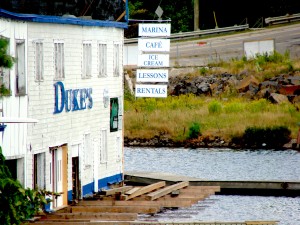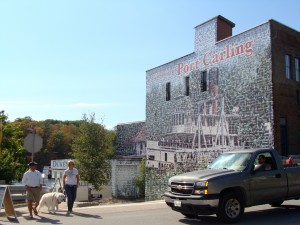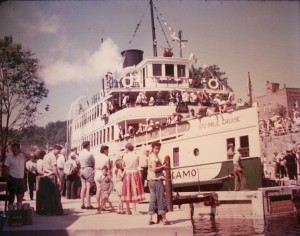Muskoka’s heritage as a vacation destination is laden with deep-rooted traditions, from its farming beginning through to its golden era of resorts, and many argue that its history is truly the thing that makes it special.
In fact, according to historian Liz Lundell, focusing on Muskoka’s heritage may be the only way for the area to attract the kind of interest it once had.

Duke Marine Services is one of the buildings involved in Doors Open Muskoka. Between 1924 and 1968, 400 boats were built at Duke’s; today the building is used to restore antique boats.
Photo by Erin Morawetz
“What we’re seeing as travel around the world becomes more homogenized, is what do we have that’s unique, that attracts people to your area, and certainly heritage is a big part of that,” Lundell says. “It’s what we do differently here that make us a place that people want to come and visit.”
“We keep talking about the benefits of preserving the heritage as part of your tourism package.”
Lundell currently sits on the Muskoka chapter of the Architectural Conservancy of Ontario, a group that formed in the absence of a Muskoka heritage committee between 2006 and 2011. One major initiative the group has undertaken is Doors Open Muskoka, a two-day event that showcases many of Muskoka’s most historic and significant buildings, such as Duke’s Marina, an old boat-building operation, the train station in Gravenhurst, and several old cottages.
Lundell says the success of the Doors Open weekend over the last number of years reinforces the significant impact that cultural tourism can have on a community, and, in turn, an economy.
“We find people come to Muskoka for it and they make a weekend out of it,” she says. “They stay overnight, they dine in restaurants, go shopping, and really take advantage of this cultural tourism.”
And Lundell says it’s not just newcomers to Muskoka who enjoy the event, but also people who have been familiar with the Muskoka region for years.
“Barkway, east of Gravenhurst, participated (in 2012) and there was a big old barn filled with family memorabilia. When I walked in in the middle of the afternoon there were 50 people in there, many who had come from great distances to come back and visit where they grew up or where their grandparents lived,” she says. “It’s a great mechanism to connect with roots.”
“Sometimes it’s local people, too, who enjoy going around the properties and hearing the history.”
For heritage expert Marc Letourneau, it is a major mistake for a community, especially one with so much heritage, to overlook the significant potential for cultural tourism.
“We keep talking about the benefits of preserving the heritage as part of your tourism package.”

Heritage is everywhere in Muskoka: the Port Carling Wall was unveiled in 2005 as part of a revitalization project for the town.
Photo by Erin Morawetz
“There are some really significant stories to be told in terms of things like logging, colonialism, our understanding of nature, and the history of tourism itself and the large resorts up there,” he says. “The resort experience is one that comes to mind for me, to be able to go to the resort and experience that self-contained place, but there are also a number of historic sites in the area that could be focused on more, and even the scenic qualities, and the stories about the scenic qualities. For example, there’s a strong First Nations presence in Muskoka, and I think there are lots of opportunities for partnership there.”
“Cultural tourism gives you the chance to highlight what’s special about a community, those unique qualities.”
And for Lundell, focusing on the unique qualities of Muskoka may just be the only answer.
“It’s a beautiful location: the forests, the lakes, the water quality,” she says. “But (there’s also) the roots, the heritage, the tradition of coming to Muskoka.”
“People who go to Europe don’t go because they want to have Subway and stay in the same kind of massive hotel room they could stay at in Toronto,” she adds. “They’re looking for an authentic experience, something real that tells a story about that locale.”
“I hope that as people become more engaged in really seeking out genuine experiences and engaging with the communities they’re visiting that they will see the value of these places that tell the story of Muskoka and continue to do so.”
“Cultural tourism gives you the chance to highlight what’s special about a community, those unique qualities.”
This shift in thinking may be just around the corner. The current Township of Muskoka Lakes council reinstated a heritage committee in 2011, something that had not existed since the previous committee disbanded in 2006.
The Port Carling Wall, unveiled in 2005, is composed of thousands of historic photos of the region, while museums in both Port Carling and Gravenhurst have dedicated rooms to Muskoka’s long history of resorts.
And in the summer of 2012, in celebration of the Segwun steamship’s 125th anniversary, there was a highly successful commemorative boat trip up the three major lakes called the “100 Mile Cruise,” a classic tourist attraction that hadn’t been offered since 1958. Tickets aboard the Segwun and the Wenonah II, another historic steamship, were sold out by mid-June, and on Aug. 18, 2012, crowds of people gathered at the locks at Port Carling, where Lake Muskoka meets Lake Rosseau, to watch the ships pass through.

The 100 Mile Cruise used to be offered quite frequently, as pictured here at Port Carling in 1953, but after 1958 it wasn’t offered until 2012.
Photo courtesy of Alf Mortimer
There indeed appears to be an appetite for not only promoting tradition and heritage in Muskoka, but also protecting it. Despite the community’s industrial history, residents in Bala, a small community between Gravenhurst and Port Carling, have banded together to fight against a proposed hydro plant to be built on the Bala Falls, arguing it will take away from the heritage and aesthetic landscape of the area. The project has been given the go-ahead, but the resistance still runs rampant.
But not everyone seems to be sold yet on the value that heritage can bring to Muskoka. Though the purpose of the heritage committee is very well supported by the Township of Muskoka Lakes council, its budget has been a topic of debate in 2013, as several councillors are skeptical of how much money heritage conservation studies are worth.
And Letourneau says it’s common for stakeholders to be hesitant about spending money on cultural tourism and heritage conservation because it’s difficult to envision the potential financial return.
The same goes when it comes to participation in traditional events. Organizers of the annual Muskoka Lakes Association Regatta, the oldest continuously run co-ed regatta in North America, are currently debating bringing in new events to entice more people to participate. Some argue that preserving the regatta in its traditional form is the most important thing, but organizers say the event must evolve with the times.
Hear for yourself the ongoing debate of how to market the Muskoka Lakes Association Regatta to today’s Muskoka vacationer—and why so many people still love it for what it is.
And live the traditional experience yourself by clicking through images of the 119th consecutive Muskoka Lakes Association Regatta. Photos by Erin Morawetz.
But by the time people in Muskoka become convinced that focusing on preserving, protecting, and promoting its heritage is the way the area can stay competitive against cheap getaways to the Caribbean or even the other tourism destinations in Ontario, will it be too late? Have too many historic hotels been destroyed, and too many massive cottages built, obscuring the region’s simplicity and charm? And most importantly, have too many people lost their connection to Muskoka’s roots to care?
Perhaps.
But now is the time to try, before Muskoka turns into a generic urban landscape of condominiums that just happen to be located beside some lakes, its past nothing more than yellowed photographs in an album: time to highlight those historic buildings and the stories that remain within their walls; time to preserve the clean lakes and natural watershed of the pristine environment; and time to remember why Muskoka is important to so many.
For once upon a time, people escaped to Muskoka.
Now Muskoka is in desperate need of an escape from what it has allowed itself to become.
